Grand Staircase-Escalante National Monument
We’ve had an amazing hiking weekend! In total, we all have hiked 12 miles in 2 days!! Brittany and Cole had such a great time this weekend…Cole says he loves hiking! He only got a little tired on the way back to the car but still he walked it all! We sure do love Utah and all the hiking it has to offer. We get to see some amazing beauty!
We decided to go a little farther away for our hike on Sunday. It took almost 2 1/2 hours of driving just to get to Grand Staircase-Escalante National Monument. We took the scenic byway 12 to get there, and we saw some great views of Red Canyon, Bryce Canyon, and finally the Grand Staircase as we passed through Escalante. There were lots of scenic turnouts along Highway 12, and we pulled over at one and got some neat pictures. By the time we got to Calf Creek Recreation Area, we were ready to get out of the car and do some hiking!
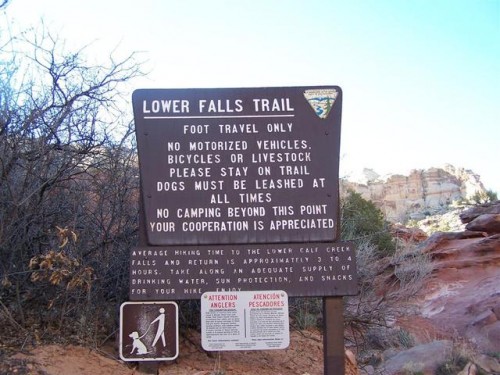
Calf Creek Falls is one of the most well known and unique features in Grand Staircase-Escalante National Monument. The trail follows Calf Creek to the 126′ high falls. The hike is 6 miles round trip and takes between 3-4 hours. Elevation change on the trail is minimal but the trail is sandy and walking can be strenuous, especially in hot weather. In the summer, it can be 100 degrees here. In contrast, the falls provide a delightfully cool, shady haven which makes the hike well worth the effort.
Early on in the trail, we saw lots of Utah Juniper trees, commonly called “cedars.” The seeds (“berries”) from these trees are eaten by wildlife, and when dried are used by Native Americans in making jewelry. We saw lots of pinyon pine trees, too. Pinyon is popular for Christmas trees, and they produce an edible nut, long used as a staple food for Indian people. The resin from this tree was used by Indians for waterproofing baskets, and for cementing turquoise stones to jewelry. We didn’t see any beaver dams on our trip, but maybe during the summer they’d be out.
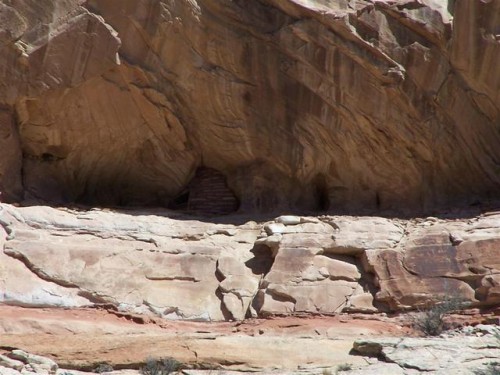
Further up the canyon, just below the rim, high on the cliffs east of the creek, we saw an ancient storage structure (granary) built some 800 to 1,000 years ago by Indians (Fremont) who farmed the canyon bottoms and stored their produce in these high, dry, probably rodent-proof structures. You’ll have to click on the picture to zoom in to see the granary.
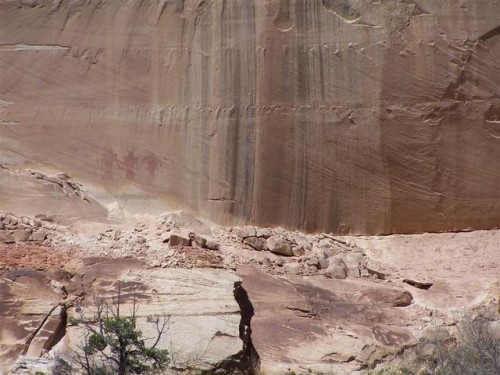
We came along an old fence line that was used back in the time of the pioneers Weaned calves were kept in the natural pasture created by the box canyon above the fence, thus giving it the name “Calf Creek.” Further down the trail, we also saw three large figures painted in red on the cliff wall. With their trapezoidal shape, depictions of arms and legs, and elaborate head dresses, these images are typical of Fremont style rock art. Archaeologists speculate that it may represent significant events, religious ceremonies, or deities. Click on the picture to zoom in to see the pictograph.
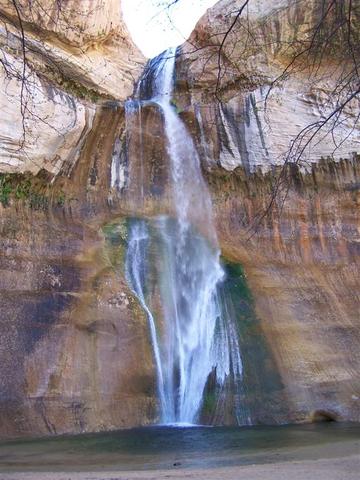
We saw a second storage granary, and we were able to see fish in the creek, and even saw a fisherman catch a fish at the waterfall. The waterfall was so amazing. Mist from the falls and shade from the canyon walls keep the temperature much cooler there. The kids and I were glad that we had our sweaters, as we put them on as soon as we got there. Here we had a nice picnic lunch, just enjoying the beautiful waterfall. The water was way too cold there for anyone to be swimming, but in the summer, I can only imagine how nice it must be to swim after a 2 3/4 mile hike one way.
After our hike, and on our way home, we decided to take a trip to Grosvenor Arch since it was only 17 miles from Cannonville. It was a combination of paved and rocky dirt road, and was a little rattling at times, especially since we were trying to get there before we ran out of sunlight. It was definitely worth the side trip. It was an amazing double arch.
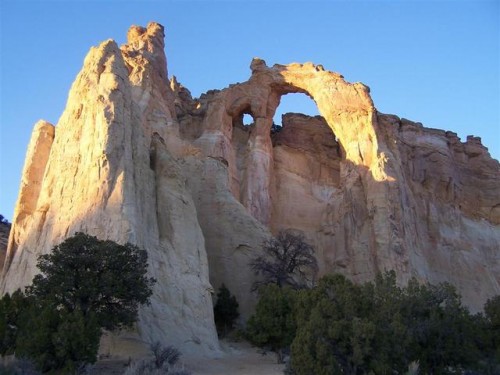
Grosvenor Arch: This is a rare, large, spectacular double arch at the end of an isolated ridge of yellowish-white Henrieville sandstone, and is one of the most photographed places in the national monument.
It was after 10 pm when we finally arrived home, and the kids had fallen asleep in the car, but a fun time was had by all! 🙂
To see the amazing waterfall and double arch pictures, click here!!!